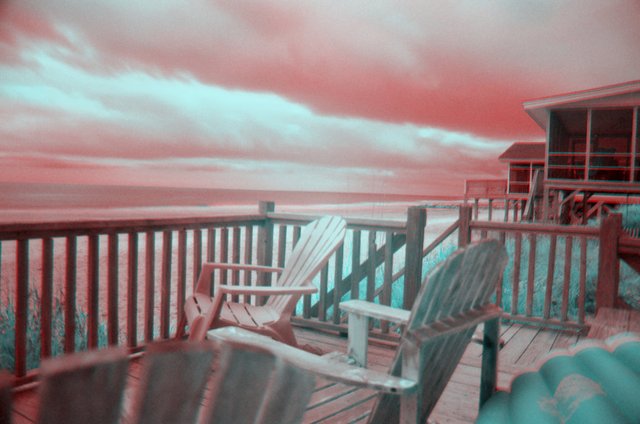Beach Chairs in Bichromatic Infrared

Pawleys Island in Infrared — This bichromatic infrared image records two different exposures capturing different wavelengths of invisible infrared light, and maps them onto complimentary colors in the visible spectrum. The "red" channel was captured with a 720 nanometer "near" infrared filter, whereas the "cyan" channel was captured with an 850 nanometer "far" infrared filter. ("Far" is a relative term here; for most applications both frequencies would be considered near-infrared, but I use "near" and "far" just to give context.)
Both the grasses on the sand dunes and the inflatable raft on the bench seem to really glow in the far infrared region.
Captured with a Nikon D7000 camera body, zoom lens at 18mm, and Polaroid IR720 filter for the red channel, and a Neewer IR850 filter for the cyan channel. Thirty second exposure for the cyan channel, two second exposure for the red channel.

Beach Chairs in Infrared by Christopher Sanborn is licensed under a Creative Commons Attribution 4.0 International License.
If you're established in SC, would be great to see some pics of Charleston in this format :)
It's a good four or five hours from me, but yes, I agree! Charleston would provide some excellent subject matter!
Infrared looks fun :) Are all these yours?
Yes! All are my own, original works.
IR is indeed quite fun. Can be done with quite ordinary equipment too. Many camera bodies have residual sensitivity to infrared (the image sensors themselves are actually quite sensitive to it, and so consumer cameras have an IR-blocking filter glued on top of the sensor... but some filters are better than others). So the trick is to get some cheap IR passband filters for the front of your lens and take REALLY long exposures. The filters look almost solid black to the naked eye, because they are blocking the visible, but letting through the IR.
I like to set up on a tripod and take multiple shots of the same scene, swapping the filter to get the image in different infrared "colors". Then combine the images into one to get "full spectrum" infrared.
I remember reading a while ago that some people would buy cheaper used DSLRs and remove the filter from the sensor to make dedicated IR cameras. Is this still doable?
Yes! I believe so! Some camera's are easier to get at the internal filters than others, I assume. I believe Olympus is a popular brand for "inexpensive" and "easy" to remove the filter, iirc. There's a few companies out there that offer "conversion services" too — try googling "IR conversion service," looks like some interesting stuff comes up.
I haven't gone that route myself. Kinda prefer the artistic constraints of "working with what i've got" (and I don't have a camera at the moment that I particularly want to devote to conversion).
You can get some pretty wild images with a converted camera, because you can still use fast shutter speeds and get a fully exposed, full-spectrum, sharp image. The results can be quite stunning in part because you get IR mixed in with visible in the end result, so it's a weird kinda hybrid.
With a stock camera and filters, I'm constrained to long exposure times, and the need to do multiple exposures if I want to span the color space. I like it though, it gives a softness and granularity, and so has it's own emotional character.